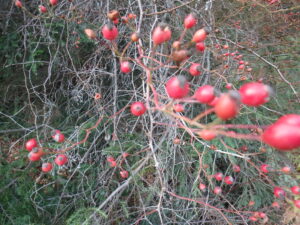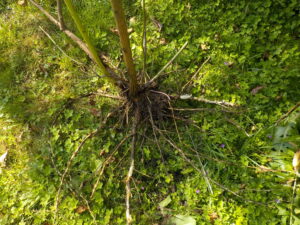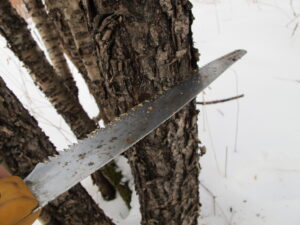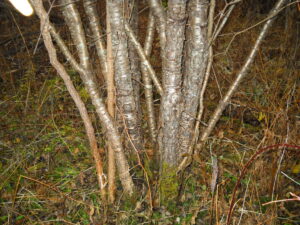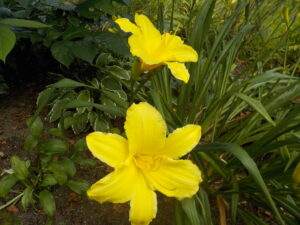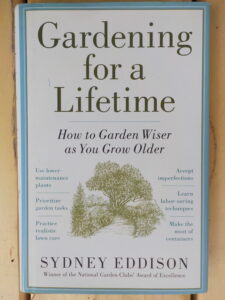Fall Flowers Are Important for Pollinators and Birds
Posted on Tuesday, September 26, 2023 · Leave a Comment
Despite my best efforts to support monarch butterflies, this year was discouraging: I only saw two monarchs visit my gardens. I have a small bed just for milkweeds, both the common one and swamp milkweed (Asclepias incarnata). But no monarchs laid eggs there this summer, no larvae ate the leaves, and I saw no butterflies sampling the nectar.
I know the importance of food for migrating monarchs at this time of year. They need to fill up on carbohydrates, fats and protein before flying long distances. That holds true for birds, too. Right now I have plenty of flowers blooming for monarchs and other pollinators, and seed heads waiting for the birds. I’m a bit discouraged, too, by the lower numbers of birds I am seeing. Let’s take a look at some of my fall favorites that migrating creatures could be feasting on.

Blue stemmed goldenrod or Solidago caesia grows in shade
According to Doug Tallamy, the guru of native plants for pollinators, the number one plant we should all have is golden rod – and we probably all do. There are dozens of species of native goldenrod, all popular with bees, moths and butterflies. Many gardeners pull them out when they show up uninvited. A few species spread by root and can take over a flower bed – but others are clump-forming. Even if you don’t want them in your beds, think about leaving them at the edges of your fields or woods.
Of those species easily found for sale in garden centers, the best is Soldidago rugosa ‘Fireworks’. This plant is 3 to 5 feet tall, and stays in an ever-expanding clump in full sun or part shade, but does not take over. Its blossoms last a long time, the stems curving gently outward, like fireworks. And no, goldenrod does not cause hay fever – that is ragweed, which blooms at the same time.
Less common is blue-stemmed or wreath goldenrod (Solidago caesia). I bought a plant 20 years ago and it is blooming now in dry shade. It really has not expanded its reach very much. It grows just 1- to 3-feet tall, but usually is about 18 inches for me. It has delicate flowers that help light up a dark spot.
New York ironweed (Vernonia noveboracensis), is a tall native plant in the aster family with purple blossoms. It is still blooming for me, a month after starting to bloom. It does this by producing lots of buds which open sequentially – so it is not always a dramatic flower in a vase. But the bees love it. It is happiest in full sun in moist soil, but there it got too big for me, so I moved mine to dry soil with only morning sun. Now it is more manageable, but still a big plant. I’ve read that if you cut it back to the ground when it is 2-feet tall, it will stay smaller – but I never remember to do so. Sigh.
Speaking of asters, there are many native species, all good for pollinators and loved especially be monarch butterflies. This year the woodland asters are quite dramatic. They are a pale lavender, and grow in shady places. Elsewhere a taller wild cousin stands 4 to 6 feet tall with deep purple or pink flowers. These grow in full sun and are often seen by the roadside at this time of year. Asters of all sorts are readily available at garden centers. Ask for native ones, not fancy hybrids.
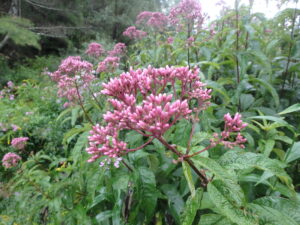
Joe Pye weed ‘Gateway’ blooms longer and better than wild forms
Joe Pye weed (Eutrochium purpurea) is another tall plant in the aster family. It can get huge – over 6-feet tall if grown in rich, moist soil. A named cultivar called ‘Gateway’ has longer lasting flowers and richer colors than the wild ones, though those are nice, too. Smaller varieties such as Little Joe, Baby Joe and Phantom are nice, and better suited for smaller gardens. I haven’t grown them but see they are sold as being 3- to 4-feet tall. Monarchs and other pollinators love them. All appreciate soil that does not dry out.
One tall annual that monarchs love is Brazilian verbena (Verbena bonariensis). It grows tall stalks that are remarkably tough – they grow 4 or 5 feet tall, but rarely need staking. Its flowers are in small clusters. It often drops seeds which send up new plants the following year.
Lastly for pollinators, I have to recommend fall crocus – which is not a crocus at all, but a Colchicum. This is a bulb plant that flowers on a six-inch stem (actually the throat of the blossom) in pink, white or lavender. It sends up foliage in the spring that dies back, then each bulb sends up a cluster of blossoms in September, or even earlier. They do best in full sun and rich soil, but do fine with some shade. They like to be fertilized each year. I often see small bees and wasps buzzing around in the blossoms.

Colchicum or fall crocus
I know that many gardeners are already cutting back their flowers in preparation for winter. But hold on! Flowers with lots of seeds can be left as winter snacks for our feathered friends. Among the best are black-eyed Susans, purple coneflower, sunflowers, zinnias, Joe Pye weed, coreopsis, sedums and ornamental grasses. Wait until spring to cut those back so that finches, chickadees, cardinals and other seed-eaters can enjoy them, especially on those cold, snowy mornings when you don’t want to go fill up your feeder.
And of course, leaving some work for spring means less work now! So leave some seeds for the birds, and enjoy watching them in the winter.
Sharpening Pruners
Posted on Tuesday, September 19, 2023 · Leave a Comment
Fall is a good time to prune deciduous trees and shrubs. Once the leaves have dropped you can see the form – and the clutter – and decide what to take out. But before you begin, think about sharpening up your pruning tools, replacing blades, or buying new ones. Dull pruning tools are like dull kitchen knives: they’ll do the job, but not very well.

This sharpener is embedded with industrial diamond chips and costs under $10
How tough is it to sharpen your own pruners? It’s really not that difficult. The biggest problem people have is overcoming their initial fear of ruining their tool by doing it wrong. You need to learn the proper angle, have the proper sharpening tool, and the patience needed to do it right. Experience will tell you if you have done well, and you won’t ruin those Felcos (the most common brand of by-pass pruners out there) even if you don’t get it quite right the first time. It’s fun, once you get the hang of it.
What do you need for sharpening tools? The best sharpeners for hardened steel tools are made using synthetic monocrystalline diamonds embedded in nickel. I like the diamond sharpeners because they are very efficient. As a rule, five to ten minutes on a conventional oilstone is equal to about a minute with a diamond sharpener. Coarse files are fine for most pruners, while fine files are better for scissors and knives that are kept very sharp.
What’s the first thing you need to do when starting off? I clean the pruners, which usually are covered with dried sap and dirt and sometimes rust. You can use soap and water, but I prefer a product called Sap-X. I let it work for 30 seconds and then scrub the blades – first with coarse steel wool and then, after reapplying the solvent, with a green scrubbie or fine steel wool to get the rust. If you don’t clean your pruners prior to sharpening, all of that debris will end up clogging your sharpener.
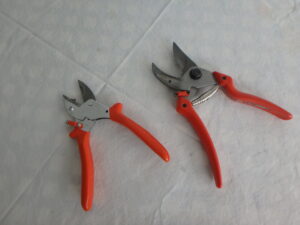
Felco pruners come in various sizes
Then what? Grasp the pruner in your left hand (if you are right-handed), holding on to the handle that extends to the cutting blade. The cutting blade is the one that moves when you open and shut the pruners, and is the only one that you need to sharpen. Steady it by placing the pruner on the edge a table. Working under a bright light helps, because it will help you to see the shiny edge that develops as you sharpen.
Start sharpening as near to the throat of the pruners as you can (where the two handles join). Place the narrow tip of the tapered file at the throat, and push the file away from you, sliding it down the length of the beveled edge. With practice you will be able to use the full length of the file as you run it down the blade.
How will you know if you are sharpening at the correct angle? What you’re trying to do is restore the edge of your pruners to the original angle set when it was manufactured. Before you start take a magic marker and “color” the steel on the beveled edge of the moveable blade. This will help you to see what you’re doing – you want to remove the marks evenly across the beveled edge with your sharpener. If only a small portion of the blade turns shiny, you need to change the angle of your file slightly.
How much pressure should you apply on your sharpening tool? Not much – let the diamonds do the work. Sharpening will feel awkward at first, but gets easier as you do it. Use nice slow even strokes.
If you don’t have pruners, buy the best ones you can afford. If you take care of them, they will outlast you. Yes, you can buy some that look like good for $10, but the quality of the steel will not be the same as buying good ones. Plan on spending $50 or more. If you can try them out before buying some, -or use a friend’s pruners- that would help you make a good choice. They all come in various hand sizes, and some are right or left handed.
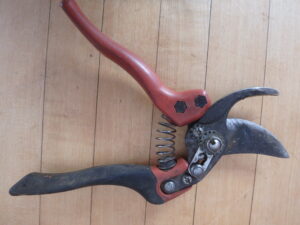
These Bahco pruners are French made and my favorties
I have tried many kinds of pruners, but my favorites are made by Bahco, a French company. I’ve had some for 20 years that have a good ergonomic design and will cut branches up to 1.25 inches in diameter. I got mine from a company in Massachusetts, OESCO (1-800-634-5557 or www.OESCOinc.com).
And what if you can’t seem to get sharpening right, then what? I’m sure with a little practice you’ll get it right! But good pruners have replaceable blades, so if you’ve been cutting steel fencing with your pruners and ruined them, you can buy a new blade.
A replacement blade for a pair of Felco pruners (which cost $60 or more new) only costs about $20. Changing a blade requires a few basic tools, some common sense, and less than 5 minutes of work. And you need to look carefully at your pruners to see which model you have. Felcos have a number on the stationary blade, depending on the model you have, anywhere from 2 to 12.
As a last resort, look in the Yellow Pages under “Sharpening Services” and you should be able to find someone to do it for you – and maybe even show you how to do it yourself next time.
Henry lives in Cornish, NH. You can reach him at
henry.homeyer@comcast.net. He is the author of 4
gardening books and offers PowerPoint presentations to
gardening clubs and libraries.
I’m lucky. Unlike many houses built in the 1800’s or early 1900’s, mine had no invasive plants when I bought it in 1970, probably because it was built as a Creamery, or butter factory. Decorative plants were not needed. Most older houses are plagued with plants brought from Asia or Europe by well-meaning people who did not know that once imported, those handsome plants might not have any predators that could keep them under control. Most of our native insects will not eat foreign plants.
Plants including Japanese knotweed, Asian bittersweet, goutweed, purple loosestrife, yellow pond iris and multiflora roses have thrived in New England – and all are nearly impossible to get rid of, once established. Unfortunately, I now have four of the six mentioned above. But no Japanese knotweed or bittersweet, thankfully (they are two of the worst).
The multiflora rose was introduced from Asia in the 1860’s as a vigorous ornamental rose and as a source of rootstock for grafted roses. In the 1930’s it was widely introduced as erosion control and alongside highways – a mature planting is so dense it can prevent cars from going over median strips. But the birds liked the rose hips – their seed pods – and it escaped cultivation.
I do not burn brush anymore because of global warming, and don’t want any errant seeds to escape, so I cut up the branches and brought them to our town recycling center. I put them into the trash going to the landfill, along with the roots. It took me about an hour to remove and cut up one plant – and I have several. But this plant can grow 10 feet or more in a year, and strangle trees or shrubs.
Buckthorn is another invasive that is common along streams and at the edge of fields. Like multiflora rose, cutting it down stimulates the roots to send up new shoots. The best way to eliminate it is to starve the roots: Take a pruning saw and cut through the bark and the green layer of cambium beneath that. Go all the way around the trunk, then repeat six inches above the first cut, and repeat. This will not kill the tree until the third year, but this slow death will not stimulate the roots to grow. Best done in winter or fall after leaf drop.
Purple loosestrife is blooming now in swamps and wet places – it is gorgeous, but outcompetes many of our native wetland plants that feed pollinators and other animals. Like many invasives, it produces huge numbers of seeds and these seeds don’t all germinate the next spring – many stay dormant for years. I’ve read that multiflora rose seeds can stay viable up to 20 years – a good reason to clear plants out when young.
My approach to purple loosestrife is to dig out new, young plants. I recognize them by their square stem, the leaf shape and the color of the stem which is often reddish. But for big established plants I just use a curved harvest knife to slice off the foliage once or more than once each summer. This prevents seed production, and reduces plant energy.
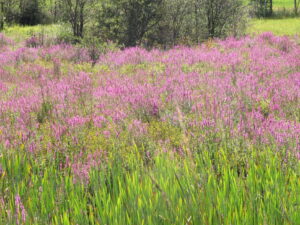 As regular readers of this column k now, I only use organic techniques in the garden. This means no chemicals including herbicides. From what I have read, most herbicides will not kill the invasives mentioned in this article. They will set them back considerably, depending on the age of the plant and the dose of the chemical. But learning to recognize all the invasives is best. And if one appears on your landscape, get rid of it immediately! And remember, persistence is important
As regular readers of this column k now, I only use organic techniques in the garden. This means no chemicals including herbicides. From what I have read, most herbicides will not kill the invasives mentioned in this article. They will set them back considerably, depending on the age of the plant and the dose of the chemical. But learning to recognize all the invasives is best. And if one appears on your landscape, get rid of it immediately! And remember, persistence is important








